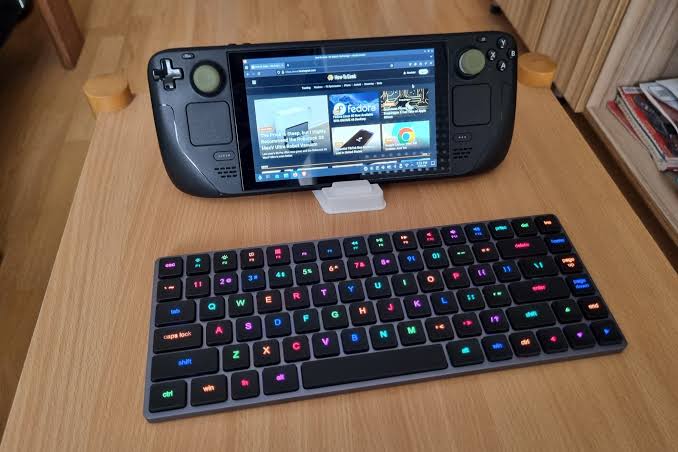The Steam Deck, Valve’s powerful handheld gaming device, is more than just a portable console. Underneath its gaming-centric interface lies a full Linux operating system, SteamOS, based on Arch Linux. This means you can transform your Steam Deck into a fully functional Linux PC, capable of running desktop applications, browsing the web, and even performing development tasks.
This detailed guide will walk you through how to use your Steam Deck as a Linux PC, covering everything from switching to Desktop Mode to installing Linux applications and peripherals for a complete desktop experience.
What Makes the Steam Deck a Linux PC?
The Steam Deck runs SteamOS, a Linux distribution tailored by Valve, which boots into Game Mode by default-a controller-friendly interface designed for gaming. However, it also includes a Desktop Mode that offers a traditional Linux desktop environment (KDE Plasma), complete with a taskbar, file manager, and the ability to install and run Linux applications just like on any other PC.
This dual-mode design lets you switch seamlessly between gaming and productivity, unlocking the full potential of the Steam Deck as a portable Linux computer.
Step-by-Step: Using Your Steam Deck as a Linux PC
1. Switch to Desktop Mode
-
Press and hold the Power button while in Game Mode.
-
Select Switch to Desktop from the power menu.
-
Wait a few seconds as the device loads the KDE Plasma desktop environment.
-
You will see a familiar desktop interface with icons, a taskbar, and a start menu.
Alternatively, you can press the Steam button, go to Power, and choose Switch to Desktop.
2. Connect Peripherals for a Desktop Experience
To get the most out of your Steam Deck as a PC, connect the following:
-
External Monitor or TV via HDMI (using the official Steam Deck Dock or a compatible USB-C hub).
-
USB Keyboard and Mouse to navigate and type comfortably.
-
USB-C Power Adapter to keep your device charged while docked.
This setup transforms your handheld into a desktop workstation, ideal for productivity or entertainment.
3. Explore the Linux Environment
-
The Steam Deck uses KDE Plasma, a user-friendly Linux desktop.
-
Open the Dolphin file manager to browse files.
-
Launch the Konsole terminal for command-line access.
-
Use the Discover Software Center to browse and install applications graphically.
You can run typical Linux programs such as web browsers (Firefox, Chrome), office suites (LibreOffice), media players (VLC), and image editors (GIMP).
4. Install Linux Applications
-
Use the Discover Software Center for easy installation.
-
For advanced users, open the terminal and use the Arch Linux package manager
pacmanto install software. -
Popular commands include:
textsudo pacman -S firefox
sudo pacman -S libreoffice
sudo pacman -S gimp
-
You can also install development tools like
gcc,vim, or IDEs for programming.
5. Manage Storage and Files
-
Access internal storage and microSD cards via the file manager.
-
Install games and applications on different storage devices to optimize space.
-
Back up important files to external drives or cloud services.
6. Customize Your Linux PC
-
Update your system regularly using:
textsudo pacman -Syu
-
Configure display settings for your external monitor.
-
Set up input devices and adjust keyboard shortcuts.
-
Install third-party tweaks and tools to enhance performance and usability.
7. Run Non-Steam Linux Games and Software
-
Download native Linux games from platforms like GOG or itch.io.
-
Use Steam’s Proton compatibility layer to run Windows games on Linux.
-
Install and run other Linux software for work, education, or entertainment.
Recommended Software for Steam Deck Desktop Mode
-
Web Browsers: Firefox, Chrome
-
Office Suite: LibreOffice
-
Image Editing: GIMP
-
Media Playback: VLC Player
-
Development Tools: VS Code, GCC, Git
-
Utilities: PeaZip (archive manager), Ultimate Media Downloader
FAQs
Q1: How do I switch back to Game Mode from Desktop Mode?
Simply reboot your Steam Deck, and it will start in Game Mode by default.
Q2: Can I use the Steam Deck without external peripherals?
Yes, but using a keyboard, mouse, and external display greatly improves the desktop experience.
Q3: Is Steam Deck’s Linux environment suitable for software development?
Absolutely. It supports terminal access, programming languages, and IDEs, making it a capable development machine.
Q4: Will all Steam games work in Desktop Mode?
Games run through Steam’s Game Mode, but you can launch Steam from Desktop Mode to play games with Proton compatibility.
Q5: Can I install a different Linux distribution on the Steam Deck?
Yes, advanced users can wipe SteamOS and install other Linux distros, but this requires technical knowledge and may affect hardware compatibility.
